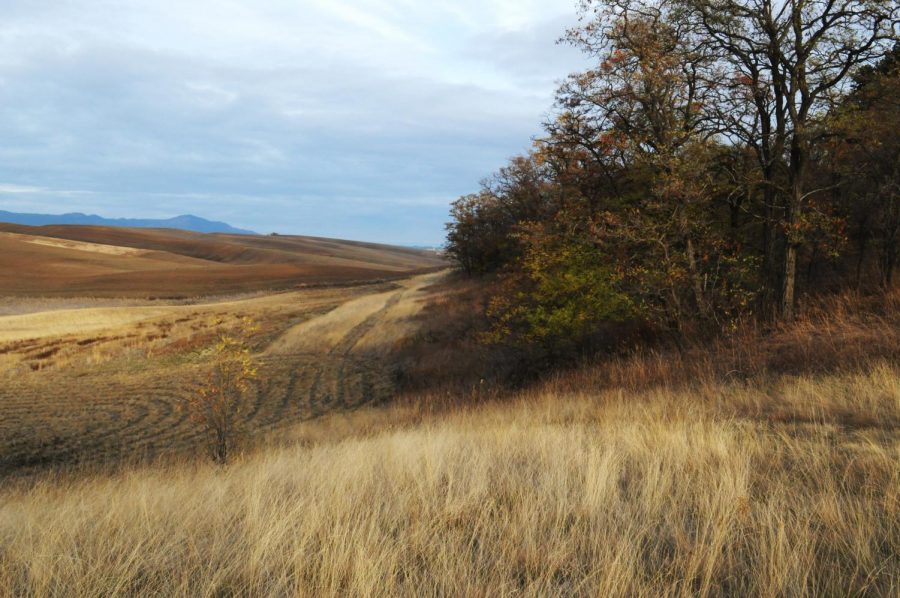Being in nature helps us connect to our ecosystem
Incorporating the natural world into our lives helps us connect to our wild roots, allowing us to better deal with environmental issues
LUKE HOLLISTER | DAILY EVERGREEN FILE
There are many places in the Palouse to go out and interact with nature that more people should go take advantage of.
July 11, 2019
It’s summertime. The sun is shining and nature seems to call out to us to enjoy life. And getting out in the wild benefits your mental health as well as nature.
Using local resources to learn about wildlife around us can foster ideas for how to more fully preserve and incorporate humans into the ecosystem.
Nature can be a quiet solitude to realize the other life about you, a place to contemplate and learn. Blake Rustman, WSU Student Health Advisory Committee chair, comments on nature as not only providing natural physical resources but mental and emotional health ones too.
“Nature is interesting as it connects us to what makes us an actual living creature,” Rustman said. “We see the trees and the birds and become more mindful of the moment. The student health advisory committee recommends being more mindful as it benefits mental health. Nature is a resource students can tap into for practicing this.”
Yet natural spaces are too often deemed separate from humans. It’s thought that to be “wild” is to be untouched, and that interacting with nature means destroying nature. Instead, humans should coexist with the world, with benefits for our health to prove it.
All animals affect nature when they interact with it. When beavers build a damn, they change a stream into a pond. When humans interact with nature, they use natural resources to change their environment to their advantage.
This manipulation isn’t always the best for other species and eventually ruins the environment and living situations with our own ecosystems. Our separatist view of man vs. nature can be to blame.
If humans admitted they were wild and natural, nature would seep more fully into our habitats as a result. Even in the tallest skyscraper, you will probably see a potted plant or two. A way to get back to the wild is incorporating nature into human spaces, leading to a more cohesive ecosystem.
Forming a cohesive ecosystem means going to the natural spaces locally available and appreciating them as well as learning the history and the conservation efforts of those places. Do not be afraid to learn and even care for them. See the giant pine in front of you and pick up the empty beer can next to it.
One great example of conservation that can also be visited is the Palouse Prairie Strip, a strip of conserved land on WSU’s campus.
Eric Roalson, the director of the The George E. Hudson Biological Reserve, said he recommends people to visit the Palouse Prairie Strip for teaching purposes.
“The more humans out in natural areas, the better off we are, and the better [nature increases] the general population’s understanding and interest in conserving natural areas,” he said.
The strip was conserved to help study and research what the Palouse looked like before the mass agriculture and urban land development of today.
“The prairie strip is used predominantly for teaching currently,” Roalson said. “It is a small piece of land and so we have to take care to not damage it.”
The Strip helps to track diversity in plants and categorize and preserve key species in the WSU herbarium collection, the largest one on the east side of Washington state. Even old wagon tracks from a trail between Moscow and Pullman can be seen etched into the soil at the strip.
This type of conservation helps to keep the past alive and nature thriving. And the way to get the most benefit from such places is to learn and act for them. Appreciate nature, form your own ideas of what the wild is and try to find your place in an ever-changing natural world.
Humans change nature, but nature changes humans and changes itself. So incorporate nature into your life. Learn that we are wild and form what wild really means to you. It is vastly important that each generation decide how to learn from nature.
In the 1960s and 70s, conservation efforts were passed in large-scale legislation, such as the Wilderness Act of 1964 that today protects 109.5 million acres of land. Nowadays, this type of legislation can feel impossible to manage, but local conservation is just as important to protecting the wild.
Local conservation can mean learning about new places and just appreciating them. Find ideas for how to make your own spaces more natural or even just pick up that old candy wrapper as you walk.
There are a lot of places to get wild in the Palouse. The Palouse Prairie Strip is located near Ferdinand’s Ice Cream and is a 15-minute walk from campus. Even if not privately accessible, this strip of land can still be viewed for teaching purposes. Magpie Forest rests on top of a hill north of campus and sports a dog park for your canine to explore.
Buffalo Eddy, the Nez Perce National Historic Park, has 4,500-year-old petroglyphs and natural conserved land to explore. Buffalo Eddy is located on the Snake River, an hour-long drive from Pullman.
Even going to the dunes on the Snake River or heading over to Sunnyside park to watch the ducks can lead to some new appreciation of the world around you.
Learning about a native species can lead to the planting of a native species, meaning appreciating nature and learning how to better become a part of our ecosystem, one step at a time.
Even keeping that one succulent you own alive is getting a little back into being wild and thriving as part of an entire ecosystem.









